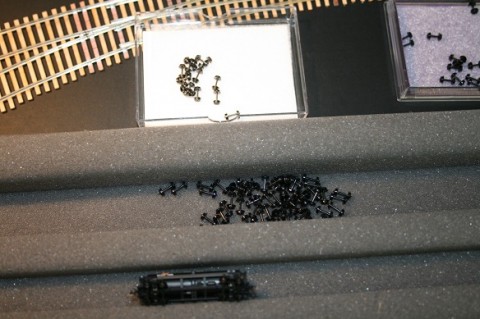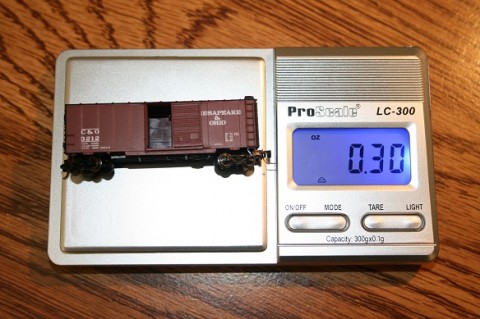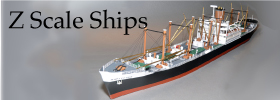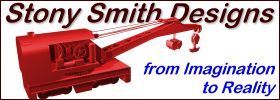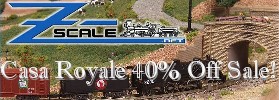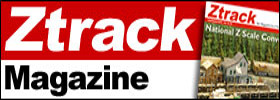Member Blogs
Avoiding the Slinky Effect
I love Kadee couplers. They are the only couplers you can (generally) reliably uncouple without sticking your fingers on the cars. They appear more realistic to my eye as well.
But I’ve read where Z folks despise the “slinky” effect. They weren’t clear on just what this means, but I suspect it breaks down into two categories:
-
Initial consist startup
-
Consist in motion
Now, when starting a consist in motion you would expect the train to stretch, even in prototypical ops. There is play in the knuckles, and so when the engine begins to pull, all of the play is removed, lending the appearance that the train stretched. This is normal, and if the Micro-Trains (MTL) couplers demonstrate this, so much the better.
However, the second type of slinky effect isn’t desirable. (An exception would be a partially filled tank car, but let’s just remove all slink!) If an in-motion car or cars slink along, the car-to-car distance expanding and contracting based on the force of the coupler springs, what you see is truly annoying. What’s true today was true 30 years ago when I modeled as a teen.
There are a few things we can do to combat this. First, make sure your track is well laid, that all pieces are properly and snuggly fit into the rail joiners, that none are loose, and that all are clean and free of debris and trash. Anything on the tracks that increases rolling resistance is your enemy.
Second, replace the plastic (Delran?) wheel sets with metal:
I haven’t done any calculations because I don’t have material data sheets, but the rolling coefficient of friction between the plastic wheel and the metal rail reasonably has to exceed the coefficient for metal on metal, which is miniscule. I’ve replaced mine with “Uncle Will’s Full Throttle” darkened wheel sets, which you see in the image.
But the more critical aspect has to be car weight. If you look at the NMRA specifications for the larger scales, all have a recommended car weight. This weight has a minimum value that increases by a set amount on a per-inch-of-car basis. In HO, for example, the minimum weight is 1 ounce, but you increase the car weight by one half ounce for every inch of car. If you have a 40’ boxcar, which in scale terms is 5.52”, then you add 2.76 ounces for a total of 3.76 ounces. This is a minimum value, but clearly we don’t want to overdo it either or we’ll have extremely short consists.
The reason for this minimum weight is light cars tend to derail on curves when coupled between heavier cars. They also tend to “eat it” on turnout frogs. You just can’t have a fluffball in the middle of your consist or things just don’t roll correctly.
In Z, our problem is there is no NMRA standard for Z gauge when it comes to car weight. So if we’re seeing this in-motion slinky effect, it’s probably in large part due to a car or cars being too light. Their weight can’t overcome the slight spring tension in the coupler, so they yank and pull, then get yanked and pulled, creating this unwanted “back and forth” effect. If you add rolling resistance to the equation, it makes things even worse. (Did I mention converting your wheel sets to metal?)
Well, shucks…no standard. So anything goes, right? Well, from the manufacturer’s standpoint, sure. But operationally, we need some guidance I would think.
So I created a spreadsheet and added the NMRA values for O through N scales, then from there extrapolated what I’d expect to see in Z gauge. The Z gauge numbers are completely fabricated on my part, but I carried through some equivalency values to check my work. The table below recreates that spreadsheet. The “Ratio” column is simply the scale, converted to a decimal number. 1:220 is really one divided by 220, or 0.0045. The starting weight and incremental weight are in ounces, with the incremental weight being added per inch of car length (as demonstrated previously).
| Name | Scale | Ratio | Start Wt. | Pct. Wt. | Pct. Ratio |
| O | 1:48 | 0.0208 | 5.00 | 0.2000 | 0.004167 |
| HO | 1:87 | 0.0115 | 1.00 | 0.5000 | 0.011494 |
| N | 1:160 | 0.0063 | 0.50 | 0.3000 | 0.012500 |
| Z | 1:220 | 0.0045 | 0.35 | 0.2857 | 0.012987 |
To verify the Z gauge values were reasonable, at least until I empirically validate them, I calculated two derived values. The “percentage weight” is the incremental weight divided by the starting weight. Or in other words, how much weight are we adding as compared to the initial weight. The “percentage ratio” is the scale ratio (0.0045 for Z scale) divided by the initial weight. Here, we’re asking if the weight is reasonable for the scale.
Looking at the numbers, we see our Z percentage values are generally in line with the other scales. The percentage weight may be a bit high, but at some point we grow small enough in scale that the wheels cannot adequately overcome friction, the springs on the couplers are too strong, and so forth. So having a slightly larger percentage weight isn’t likely a bad thing. Maybe we couldn’t pull a hundred car consist, but that would be unlikely anyway, even with an MTL F7 (reputed to be strong pullers). Ask yourself which you prefer, longer but slinky consists or slightly shorter but not slinky consists.
For grins I pulled a 40’ boxcar in Z scale and weighed it. Note this is with metal wheels, which I anticipate are slightly heavier than factory plastic:
Hmm. 0.30 ounces. That’s a bit light. If the car length is true to prototype, it should be 2.16” in length, so I should add about 0.25 ounces of weight to this car, and I’d do so half over each truck for balance. By the way, if you’re interested in the weight scale itself, I found it here:
It cost less than $10 US. It’ll become a handy tool, assuming my calculations (and hunches) are correct!
Finally, this is all mathematical/theoretical. Once I finish my layout I’ll do some testing and report back any adjustments. I have also read about knuckle modifications that may or may not be required as the weight of the consist increases. There is apparently casting flash that should be removed if you want the knuckle to fully grip its partner. Before I go to that kind of solution, I’ll try pulling some cars to see if they decouple on the track for no apparent reason. Those are some pretty small couplers to be filing if they don’t need to be filed!
Comments 1
Yes! I remember this post a while back and I bought the proscale LC300. Great piece of equipment. I needed it for the new milk car or butter dish car I designed and 3D printed. I made them a two piece so I could add weights under the cover. I started using the scale weights found in hobby lobby for the wooden cars you put together. these weights were just the right shape. flat on the bottom with acurved top fit perfect under the dish type cover. Since these milk car are plastic and very light when pulling them I get the slinky effect and I do have the plastic wheel set on them still. I have almost every thing I need to finish 10 cars with decals. But adding the same weight to each car I found that the GP-38-2 had a lot of problems pulling the ten cars up a 2% grade which I have on my layout at this time. I will have to try this wheel change I would have to buy a lot of wheels. and see if I still have the same problem with the single GP-38-2 or have two Engines pulling them a double header!

